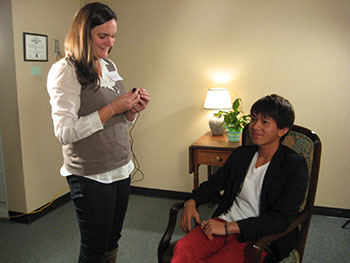Young Historians, Living Histories- Today’s Stop: Cleveland, OH!
Special thanks to Paula Lee, Smithsonian Affiliations intern, for this guest post. This is the fourth of a five-part blog series she is writing as part of the Young Historians, Living Histories (YHLH) collaboration with the Asian Pacific American Center and our Affiliate network.
In Cleveland, students began an early session of preliminary interviews because practice after-all makes perfect. Dr. John Grabowski, Senior Vice President of Research and Publications of Western Reserve Historical Center (Cleveland, OH), sought out partnership with local Asian Indian American community, the Asian Indian Heritage Project (AIHP). WRHS and AIHP, having had a previous history of partnerships, rekindled their alliance and worked to produce an advertisement that was placed in two local newspapers, India International and The Lotus for recruits based off short essays. Six highly dedicated and intelligent youth from the Asian Indian community were selected to represent the Northeast Ohio population.
Read more about the students’ films at CAAM Fest here.

Interviews held inside the Western Reserve Historical Society Library utilizing the tall windows as natural lighting for filming
Students were paired and interviewed successful doctors, community leaders (founder of AIHP Mr. Paramijit Singh) and social workers gathering a riveting collection of stories in the duration of their hour-long interviews. The museum provided its Research Library to create a professional theme for the filming to take place, while interviewees dressed in traditional Indian clothing as a reminder of their culture in the midst of relocation and adaptation in America. When they weren’t asking for help editing footage through Dr. Grabowski or Jane Mason, Vice President of Marketing and Communications, students would take the camcorders and complete the editing as home projects. Each student dove into the project with such passion and enthusiasm, they even gathered at the museum on their own over Thanksgiving break to continue without pause!
In a follow up call with Marketing Assistant Alyssa Purvis, I was informed that that the AIHP held a banquet selling raffle tickets to raise funds for the next set of students eager to continue with the project having already received inquiries.
“The students are a huge driving force behind the continuation of this project; they keep meeting others within their community and wanting to preserve their stories.” Their efforts “have had a ripple effect, on their families and entire Indian community as a whole in Northeast Ohio.
Through all those involved in Young Historians, Living Histories, I amongst many others have had a chance to discover how proactive these youth are when it comes to using these community resources. It is amazing to see how well the youth are responding to this form of research and discovery.
As the Asian Indian Heritage Project mantra goes, we hope our accomplishments “Illuminate the Past, Light the Future”!





















 Smithsonian Immigration/Migration Initiative (SIMI)
Smithsonian Immigration/Migration Initiative (SIMI)


